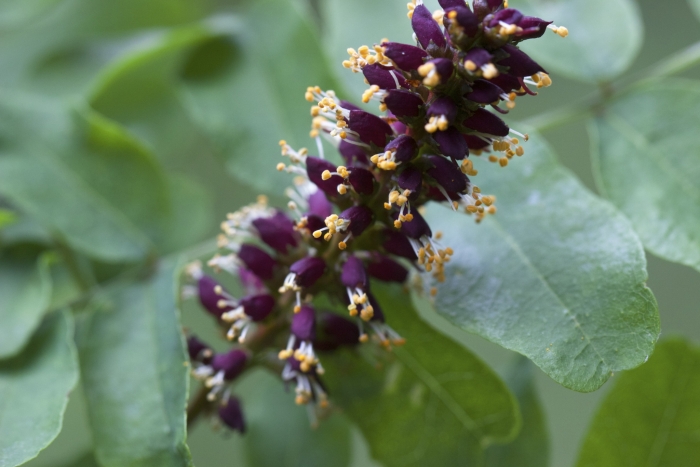California False Indigo
(Amorpha californica)
California False Indigo (Amorpha californica)
/
/

icosahedron
CC BY 4.0
Image By:
icosahedron
Recorded By:
Copyright:
CC BY 4.0
Copyright Notice:
Photo by: icosahedron | License Type: CC BY 4.0 | License URL: http://creativecommons.org/licenses/by/4.0/ | Rights Holder: icosahedron | Publisher: iNaturalist | Date Created: 2018-04-30T13:10:30-07:00 |




























































Estimated Native Range
Summary
Amorpha californica, commonly known as California False Indigo, is a deciduous shrub native to chaparral, foothill woodlands, and the coastal sage scrub of California. It is well-adapted to its Mediterranean climate with dry summers and wet winters. This species typically grows to a height of 3-6 feet (0.9-1.8 meters) and a similar width, with a rounded form. The leaves are pinnately compound with small, oval-shaped leaflets that are not spiny but have resin glands at the tips. From late spring to early summer, it produces striking inflorescences that are spike-like racemes of small, violet flowers with a single petal and conspicuous, protruding stamens, which are attractive to pollinators. The fruit is a small legume pod that typically contains a single seed.
California False Indigo is appreciated for its drought tolerance, low maintenance requirements, and the ability to attract beneficial insects and pollinators. It is used in native plant gardens, as a component of wildlife-friendly landscapes, and for erosion control on slopes. It thrives in full sun to part shade and prefers well-drained soils, tolerating a range of soil types from sandy to loamy. While it is drought-tolerant once established, it benefits from occasional watering during prolonged dry periods. There are no widely known cultivars of this species in the horticultural trade. Potential problems include root rot in poorly drained soils and occasional pest issues such as aphids. It is not known to be invasive when grown outside its native range.CC BY-SA 4.0
California False Indigo is appreciated for its drought tolerance, low maintenance requirements, and the ability to attract beneficial insects and pollinators. It is used in native plant gardens, as a component of wildlife-friendly landscapes, and for erosion control on slopes. It thrives in full sun to part shade and prefers well-drained soils, tolerating a range of soil types from sandy to loamy. While it is drought-tolerant once established, it benefits from occasional watering during prolonged dry periods. There are no widely known cultivars of this species in the horticultural trade. Potential problems include root rot in poorly drained soils and occasional pest issues such as aphids. It is not known to be invasive when grown outside its native range.CC BY-SA 4.0
Plant Description
- Plant Type: Shrub
- Height: 3-6 feet
- Width: 3-6 feet
- Growth Rate: Moderate
- Flower Color: Purple
- Flowering Season: Spring, Summer
- Leaf Retention: Deciduous
Growth Requirements
- Sun: Part Shade
- Water: Medium
- Drainage: Medium, Fast
Common Uses
Bee Garden, Butterfly Garden, Deer Resistant, Low Maintenance
Natural Habitat
Native to chaparral, foothill woodlands, and coastal sage scrub of California
Other Names
Common Names: Mock Locust
Scientific Names: , Amorpha californica, Amorpha hispidula,
GBIF Accepted Name: Amorpha californica Nutt.